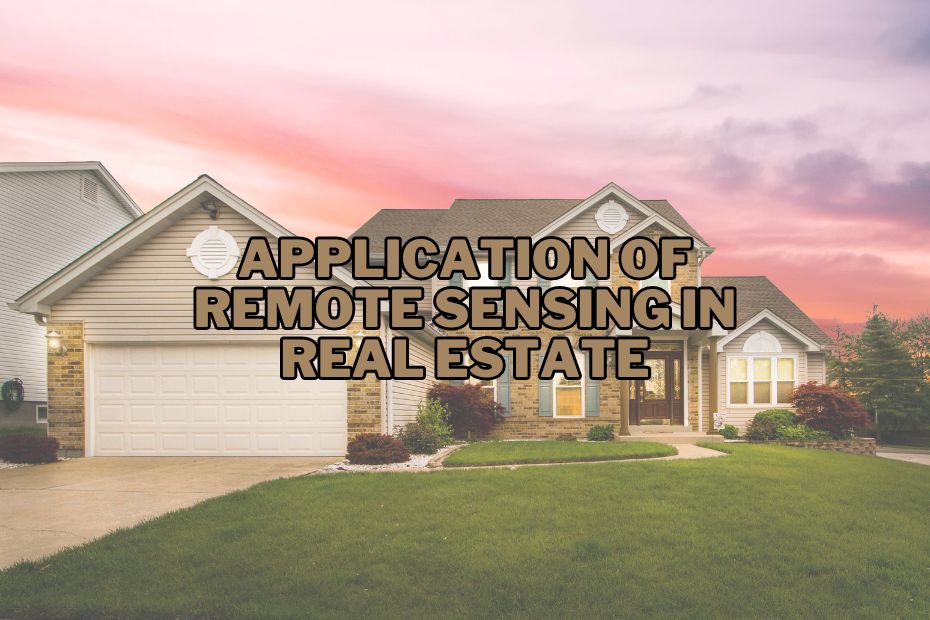In the dynamic world of real estate, where every square meter counts, gaining a competitive edge is paramount. Remote sensing, a cutting-edge technology, has emerged as a game-changer. It empowers real estate professionals with unparalleled insights and capabilities, revolutionizing the industry from property valuation to infrastructure monitoring. In this article, we delve into the multifaceted application of remote sensing in real estate, unveiling its transformative potential.
Remote sensing in real estate involves using satellite imagery and aerial photography to assess property conditions, monitor land use changes, and identify potential development opportunities. It provides valuable data for property valuation, environmental impact assessments, and urban planning.
Application of Remote Sensing In Real Estate
Remote sensing is like having a magic lens that allows you to see and gather information about the Earth’s surface from a distance. It involves using sensors and cameras on satellites, drones, or aircraft to capture data without any physical contact with the objects being observed. This technology has found numerous applications in the real estate sector, making it more efficient, cost-effective, and environmentally friendly.
1. Property Valuation
Property valuation is the bedrock of real estate, and remote sensing brings a seismic shift in this domain. Traditional methods often rely on manual inspections and limited data, leading to inaccuracies. Remote sensing technologies, such as LiDAR (Light Detection and Ranging) and satellite imagery, provide detailed 3D models, precise measurements, and historical data, enhancing the accuracy of property appraisals.
2. Urban Planning
In the ever-expanding urban landscapes, efficient urban planning is crucial. Remote sensing aids city planners by providing high-resolution images, land use analysis, and traffic pattern data. This information facilitates informed decisions, helping create sustainable and livable urban environments.
3. Environmental Impact Assessment
Real estate development can have profound environmental implications. Remote sensing allows for thorough environmental impact assessments. It helps identify potential risks, assess habitat disturbances, and monitor changes over time, ensuring responsible development practices.
4. Property Inspection
Routine property inspections are essential for maintaining real estate assets. Drones equipped with remote sensing technology can swiftly and safely inspect properties, identifying maintenance needs and security breaches, all while reducing operational costs.
5. Disaster Management
Natural disasters pose significant threats to real estate investments. Remote sensing plays a pivotal role in disaster management by providing real-time information on disaster extent and damage assessment. This enables rapid response and informed decision-making.
6. Land Use Planning
Efficient land use planning is fundamental to optimizing real estate investments. Remote sensing data offers insights into land cover, land use change, and urban sprawl, assisting in identifying potential investment opportunities and threats.
7. Flood Risk Assessment
Flooding can devastate properties and communities. Remote sensing helps assess flood risks by monitoring water levels, identifying vulnerable areas, and predicting potential flood events. This knowledge empowers property developers and homeowners to take preemptive measures.
8. Property Marketing
Remote sensing transforms property marketing by providing stunning aerial views and 3D virtual tours. Potential buyers can explore properties from the comfort of their homes, enhancing the marketing reach and impact.
9. Infrastructure Monitoring
Maintaining infrastructure is a costly affair for real estate developers. Remote sensing aids in monitoring the condition of infrastructure assets, from roads to bridges. It helps identify maintenance needs proactively, reducing repair costs.
10. Energy Efficiency
Energy-efficient properties are in high demand. Remote sensing helps assess the energy performance of buildings by analyzing thermal data. This information enables property owners to make improvements that not only reduce costs but also appeal to environmentally conscious buyers.
11. Risk Assessment
Real estate investments come with risks. Remote sensing offers tools for risk assessment by providing data on geological hazards, climate patterns, and social demographics. This information enables investors to make informed decisions and mitigate potential risks.
12. Property Security
Security is a top concern for property owners. Remote sensing technologies like surveillance cameras and motion detectors enhance property security. They can be integrated with alarm systems, providing real-time alerts in case of intrusions.
The applications of remote sensing in real estate are diverse and powerful. However, to harness its full potential, it is essential to stay updated on the latest developments in remote sensing technology and methodologies. As this technology continues to evolve, it will likely open up new possibilities for real estate professionals, further enhancing efficiency and decision-making in the industry.
Conclusion
Remote sensing has emerged as a formidable ally in the real estate industry, reshaping how professionals operate and make decisions. From property valuation to infrastructure monitoring, its applications are vast and transformative. As technology advances, the integration of remote sensing in real estate practices will become even more prevalent, offering unprecedented insights and efficiencies. Embracing this technology is not just a choice but a necessity for those looking to thrive in the competitive world of real estate.
FAQs: Application of Remote Sensing In Real Estate
How does remote sensing improve property valuation in real estate?
Remote sensing technologies provide detailed 3D models, precise measurements, and historical data, enhancing the accuracy of property appraisals.
How can remote sensing enhance property security?
Remote sensing technologies like surveillance cameras and motion detectors enhance property security by providing real-time alerts in case of intrusions.
What are the benefits of using remote sensing for real estate appraisal?
Benefits include cost-effective property assessment, the ability to monitor changes in property conditions, and the identification of environmental factors that may impact real estate value.
What are the challenges of using remote sensing in real estate?
Challenges include the cost of high-resolution imagery, data accuracy, and the need for specialized expertise to interpret and utilize the data effectively.
